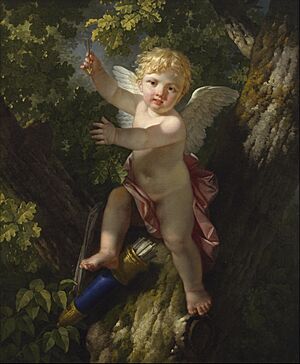Cupid facts for kids
In Roman mythology, Cupid is the god of love. He is often shown as a cute, winged boy. People connect him with the Greek god Eros. Another name for Cupid is Amor, which means love in Latin.
Today, many people think of Cupid around Valentine's Day. He is often pictured with his bow, ready to shoot arrows that make people fall in love.
Contents
Who Are Cupid's Parents?
There are different stories about who Cupid's parents were. Some ancient writers said he was the son of Mercury (the messenger god) and Diana (goddess of the hunt). Other stories say his parents were Mercury and Venus (goddess of love). A third idea was that he was the son of Mars (god of war) and Venus.
One common story says Cupid was the son of Jupiter (the king of the gods) and Venus. This Cupid is often seen as a playful young boy who loves to cause mischief and spread love.
Cupid was worshipped alongside his mother, Venus. People believed his power was even greater than hers. He was thought to have power over the dead, sea creatures, and even the gods on Mount Olympus.
How is Cupid Shown in Art?

In painting and sculpture, Cupid is usually shown as a young boy with wings. He carries a bow and a quiver full of arrows. The traditional Christian image of a cherub is based on how Cupid was shown.
In art, Cupid is often seen playing. He might be rolling a hoop, throwing darts, or chasing a butterfly. Sometimes he is shown flirting with a nymph (a nature spirit).
He is often pictured with his mother, Venus. He might be playing a horn. Sometimes, he is even shown wearing a helmet and carrying a shield. This might be a playful way to show that love can be like a war, or that love conquers all.
Cupid in Stories and Poems
Cupid appears a lot in poems and love stories. He is known for being unpredictable and playful. He is often shown with two kinds of arrows:
- One set has gold tips, and these arrows make people fall in love.
- The other set has lead tips, and these arrows make people feel hatred.
One of the most famous stories about Cupid is the tale of Cupid and Psyche. In this story, Cupid himself falls in love with a mortal princess named Psyche.
Images for kids
-
Cupid Carving His Bow (1620s) by François Duquesnoy, Bode Museum, Berlin
-
Edme Bouchardon, Cupid, 1744, National Gallery of Art
-
Bronze Cupid Sleeping on a lion skin (1635–40), based on a marble statue by Praxiteles
See also
 In Spanish: Cupido para niños
In Spanish: Cupido para niños






